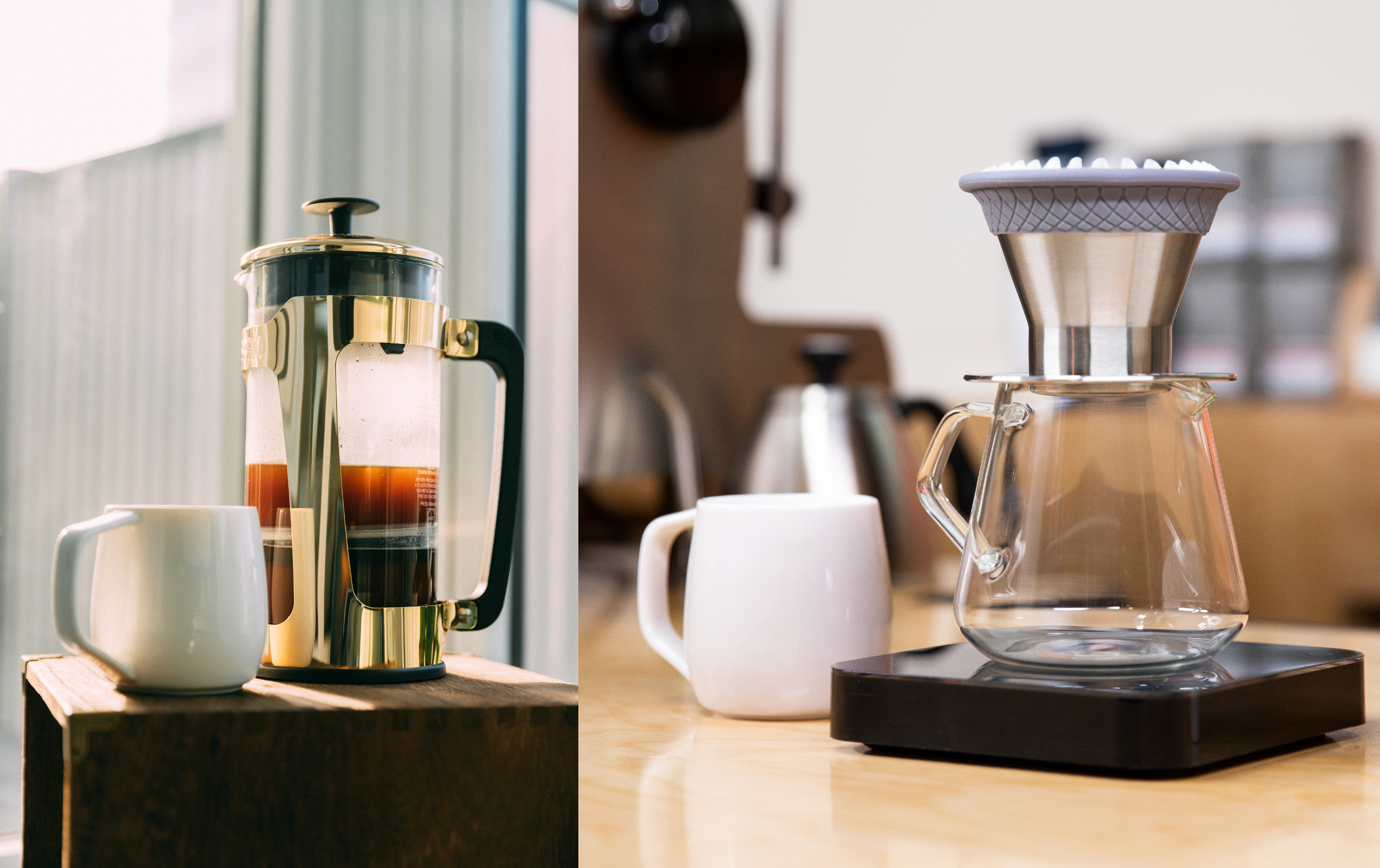French Press vs Pour Over Coffee: Discover Which Is Better For You
Industry
Move over, automatic coffee pots. Manual coffee makers like the french press and pour over are exploding in popularity. They last longer, they enhance the overall brewing experience, and—most importantly—they enable anyone to brew incredible, cafe-quality coffee.
But which is best for you?
We’ll guide you through the key differences between french press vs pour over coffee makers so you can choose the perfect brewer and make A+ coffee you love at home.
These two titans in the coffee world each come with their pros and cons, and it’s important to be aware of them before you choose which to make your daily brewer.
Read to discover…
-
The #1 thing people can’t stand about the french press (and the only way to fix it)
-
Exactly what kind of coffee lover will prefer pour over brewing
-
Why pour over brewers are so diverse—and how to pick the right one
By the end, you’ll know which type of coffee maker is right for you
French Press Coffee 101: The Classic Coffee Maker
There’s a reason movies and TV shows often feature a french press in kitchen scenes. It’s the quintessential coffee maker. Classic. Timeless. Idyllic.
The french press is, for millions of people, the entryway to a world of unbelievably delicious coffee. Perhaps you can remember your first cup of french press coffee at a fancy cafe—and that shocked feeling of your taste buds being blasted with flavor.
The french press will always be a world-favorite, but is it right for you and your home?
How French Press Coffee Brewing Works
Making coffee in a french press is easy and straightforward.
The device is essentially a large container, with a metal filter attached to the end of a rod. There are no complex mechanics, no electrical parts. You can fill the whole thing to make multiple cups of coffee, or you can just fill a small part for a single mug.
It’s about as simple as it gets for coffee makers.
We call it “immersion” brewing, because the grounds and water simply steep together for the extraction to take place. Here’s the brewing process:
-
Step 1: Mix the coffee and water. Dump coarse grounds into the french press carafe, followed by hot water. Pouring the water in a circular motion helps ensure all the grounds are evenly saturated.
-
Step 2: Set a timer for 4 minutes. The magic is happening.
-
Step 3: After 1 minute, submerge any floating grounds. Some coffee may form a ‘crust’ at the top of the press. Gently submerge them with a spoon or paddle to make sure they all brew evenly.
-
Step 4: After 4 minutes, lower the plunger. You’ve achieved a balanced extraction, so push the plunger down slowly and pour out your coffee.
Read our full french press coffee guide here.
You don’t want to leave the brewed coffee in the french press, or it will keep extracting and become bitter after a few minutes. It’s important to pour all the coffee into mugs or another server as soon as the brew is complete.
|
The unique filters of the ESPRO Press are 12x finer than traditional filters, so when you press the plunger down, the brewing actually stops and you can leave the coffee in the press without it becoming bitter. |
What French Press Coffee Tastes Like
The french press produces a very distinct coffee flavor.
-
It’s bold and rich. The four-minute brew creates a dense, unmistakable flavor. While it’s not always easy to pick out the most nuanced flavors, it’s impossible not to fall in love with the full, confident flavor.
-
It has a heavy body. The metal filter lets a small amount of “micro-grounds” through to your final cup. These teeny-tiny particles give the coffee a full, heavy feeling.
-
The natural acidity is muted. Micro-grounds keep your tongue from being able to taste all the coffee’s natural acids, so french press coffee often seems less tangy.
Those micro-grounds can be a burden, however. They tend to sink to the bottom of the cup, making the last couple of sips feel gritty or sludge-y. It’s the one thing 99% of coffee lovers don’t like about the french press.
|
ESPRO’s zero-grit french press filters are so fine, you never have to worry about sludge at the bottom of your cup. It’s the only way to make a clean cup of french press coffee that’s good to the last sip. |
Advantages Of The French Press
There’s a lot to love about french press coffee.
-
Simple brewing process
-
Insanely flavorful coffee
-
Consistent extraction every time
-
Makes 1-4 cups of coffee
-
Zero paper waste
-
Perfect for making cold brew coffee
Disadvantages Of The French Press
The classic coffee maker isn’t without a few drawbacks.
-
Gritty last few sips
-
Overpowers nuanced, complex flavors
-
Four minutes is sometimes too long
-
Cleanup is simple, but not fast
Is French Press Coffee Bad For You?
Coffee is overwhelmingly healthy for most people, but if you’re someone with high cholesterol or triglyceride levels, you may want to avoid french press coffee.
Multiple studies have demonstrated that unfiltered coffee tends to increase circulating LDL and triglyceride concentrations. This is due to compounds cafestol and kahweol, which are naturally found in coffee oils. They are retained in paper filters, however, so you can enjoy paper-filtered coffee risk-free.
Some french presses can use paper filters for a bold, but clean brew.Pour Over Coffee 101: Hands-On Brewing At Its Finest
You may think of bearded baristas at hip cafes when you see pour over coffee brewers, but this style of coffee actually goes back centuries—and it’s making a major comeback. Millions of homes (and thousands of cafes) around the world make pour over coffee daily, and when you try it for yourself, it’s not hard to understand why.
The process is meditative, it infuses your coffee ritual with focus and intentionality in a unique way, and the resulting flavor is stunning.
Is a pour over coffee maker right for you? Let’s see.
How Pour Over Brewing Works
The concept is simple: you place coffee grounds in a cone-shaped device with a filter, pour water over the top, and let gravity pull the brewed coffee down into a cup or server below. The coffee and water are only in contact for a short amount of time—rather than a prolonged steep—so a medium grind size is used to speed up extraction.
The brewer itself is simple too. There are no wires that might break over time and no complex parts. You can brew up to three mugs of coffee at a time.
In practice, there’s a small learning curve involved.
-
Step 1: Initial setup. Rinsing the filter removes any papery taste and pre-heats the brewer. Medium to medium-coarse grounds are then added and the brewer is placed directly over a mug or server.
-
Step 2: Start the bloom. Pour a small amount of water over the coffee grounds to initiate the “bloom”. Resting for 30 seconds allows the grounds to expel the gas trapped within, which prepares the coffee for an even, flavorful extraction.
-
Step 3: Pour in slow circles. Slow, concentric circles—in and out—ensure all the grounds are evenly saturated by the incoming hot water. This part takes a little focus, but is very calming and meditative.
-
Step 4: Let it drain. The water will drain through the grounds, becoming brewed coffee, and fall into the cup or server below. When the draining slows to a drip, your coffee is ready.
You can read our full pour over coffee guide here.
Don’t leave the coffee grounds over your final cup for long. Tiny drops of water will still fall through the grounds slowly, picking up bitter (over extracted) flavors, so remove the brewer from the cup or server when the draining is complete.
|
We designed the ESPRO Bloom Pour Over Coffee Brewer with a new type of brew bed so there’s much less risk of pouring your water incorrectly. The brewer walls naturally funnel the water through the coffee evenly, producing a balanced flavor every time. |
What Pour Over Coffee Tastes Like
Pour over coffee tends to have a more familiar, balanced flavor compared to bold french press coffee.
-
It’s clear and nuanced. The faster brew time and paper filter work together to make coffee with a high level of flavor clarity, where you can easily taste the coffee’s most nuanced flavors and aromas.
-
It’s light and clean. Micro-grounds can’t make it through the paper filter, so pour over coffee often has a light, clean mouthfeel. No grit, no sludge—just smooth coffee.
-
The acidity is a little brighter. Without micro-grounds coating your tongue, you’re more capable of tasting the natural, pleasant acids that give all the other flavors a little ‘pop’.
Every pour over coffee maker uses its own brewing process, producing somewhat different coffee. But generally, these flavor notes are characteristic of pour over coffee.
|
We designed Bloom Pour Over Coffee Brewer to work with or without a paper filter, so you can switch between bolder metal-filtered coffee and lighter paper-filtered coffee on demand. It’s the best of both worlds in one coffee maker. |
Advantages Of Pour Over Brewing
Making pour over coffee has exploded in popularity for a handful of reasons.
-
Meditative process draws you into the coffee experience
-
Clean, balanced, complex coffee flavors
-
Makes 1-3 cups of coffee
-
Use forever / unlikely to break
-
Cleanup is simple and fast
-
Perfect for “flash chilled” iced coffee
Disadvantages Of Pour Over Brewing
Being hands-on, pour over coffee does have drawbacks worth mentioning
-
Slight learning curve
-
Prone to inconsistent flavor with poor technique
-
Paper filters often required
-
Some brewers take 6-7 minutes
What If We Could Eliminate The Disadvantages?
Drinking a frustratingly unbalanced cup of pour over coffee because your technique wasn’t perfect isn’t a problem anymore. A mouthful of grit from your french press coffee—also a thing of the past.
We’re designing a new wave of coffee brewers that solve the most common disadvantages so you can enjoy cafe-quality coffee at home—without having to endure inconsistent flavor, gritty last sips, or hard-to-learn techniques.
Which Coffee Brewer Is Better For You?
Now that you know all about how french press and pour over brewers work—and how to avoid the most common drawbacks—it’s time to discover which kind of coffee maker is right for your tastes and lifestyle.
You’ll Love A French Press If…
-
The romance of the french press captivates you
-
A full-bodied, rich cup of coffee sounds amazing
-
You want to enrich your daily ritual, but don’t want it too hands-on
-
More than 2-3 people need coffee at a time
-
You ever want to make cold brew coffee
You’ll Love A Pour Over Brewer If…
-
The craftsmanship of pour over brewing excites you
-
Clean, complex, or exotic flavors sound amazing
-
You love having full, hands-on control over your coffee
-
2 minutes is all you have to spare in the morning
-
You ever want to make “flash chilled” iced coffee
You have every piece of information you could need to make this decision.
What’s it going to be?
Happy brewing,
Your friends at ESPRO













